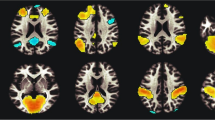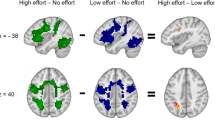Abstract
Rationale
The default mode network (DMN), one of several resting-state networks (RSN) in the brain, is thought to be involved in self-referential thought, awareness, and episodic memories. Nicotine improves cognitive performance, in part by improving attention. Nicotinic agonists have been shown to decrease activity in regions within DMN and increase activity in regions involved in visual attention during effortful processing of external stimuli. It is unknown if these pharmacological effects also occur in the absence of effortful processing.
Objectives
This study aims to determine if nicotine suppresses activity in default mode and enhances activity in extra-striate RSNs in the absence of an external visual task.
Methods
Within-subject, single-blinded, counterbalanced study of 19 non-smoking subjects who had resting functional MRI scans after 7 mg nicotine or placebo patch. Group independent component analysis was performed. The DMN component was identified by spatial correlation with a reference DMN mask. A visual attention component was identified by spatial correlation with an extra-striate mask. Analyses were conducted using statistical parametric mapping.
Results
Nicotine was associated with decreased activity in regions within the DMN and increased activity in extra-striate regions.
Conclusions
Suppression of DMN and enhancement of extra-striate resting-state activity in the absence of visual stimuli or effortful processing suggest that nicotine's cognitive effects may involve a shift in activity from networks that process internal to those that process external information. This is a potential mechanism by which cholinergic agonists may have a beneficial effect in diseases associated with altered resting-state activity.




Similar content being viewed by others
References
Bandettini PA, Bullmore E (2008) Endogenous oscillations and networks in functional magnetic resonance imaging. Hum Brain Mapp 29:737–739
Bell AJ, Sejnowski TJ (1995) An information-maximization approach to blind separation and blind deconvolution. Neural Comput 7:1129–1159
Bentley P, Husain M, Dolan RJ (2004) Effects of cholinergic enhancement on visual stimulation, spatial attention, and spatial working memory. Neuron 41:969–982
Biswal B, Yetkin FZ, Haughton VM, Hyde JS (1995) Functional connectivity in the motor cortex of resting human brain using echo-planar MRI. Magn Reson Med 34:537–541
Brody AL, Olmstead RE, London ED, Farahi J, Meyer JH, Grossman P et al (2004) Smoking-induced ventral striatum dopamine release. Am J Psychiatr 161:1211–1218
Broyd SJ, Demanuele C, Debener S, Helps SK, James CJ, Sonuga-Barke EJ (2009) Default-mode brain dysfunction in mental disorders: a systematic review. Neurosci Biobehav Rev 33:279–296
Calhoun VD, Adali T, Pearlson GD, Pekar JJ (2001) A method for making group inferences from functional MRI data using independent component analysis. Hum Brain Mapp 14:140–151
Calhoun VD, Maciejewski PK, Pearlson GD, Kiehl KA (2008) Temporal lobe and “default” hemodynamic brain modes discriminate between schizophrenia and bipolar disorder. Hum Brain Mapp 29:1265–1275
Cordes D, Haughton VM, Arfanakis K, Carew JD, Turski PA, Moritz CH et al (2001) Frequencies contributing to functional connectivity in the cerebral cortex in “resting-state” data. Am J Neuroradiol 22:1326–1333
Correa N, Adali T, Calhoun VD (2007) Performance of blind source separation algorithms for fMRI analysis using a group ICA method. Magn Reson Imag 25:684–694
Damoiseaux JS, Rombouts SA, Barkhof F, Scheltens P, Stam CJ, Smith SM et al (2006) Consistent resting-state networks across healthy subjects. Proc Natl Acad Sci USA 103:13848–13853
Fant RV, Henningfield JE, Shiffman S, Strahs KR, Reitberg DP (2000) A pharmacokinetic crossover study to compare the absorption characteristics of three transdermal nicotine patches. Pharmacol Biochem Behav 67:479–482
Foulds J, Stapleton J, Swettenham J, Bell N, McSorley K, Russell MA (1996) Cognitive performance effects of subcutaneous nicotine in smokers and never-smokers. Psychopharmacology (Berl) 127:31–38
Franco AR, Pritchard A, Calhoun VD, Mayer AR (2009) Interrater and intermethod reliability of default mode network selection. Hum Brain Mapp 30:2293–2303
Garrity AG, Pearlson GD, McKiernan K, Lloyd D, Kiehl KA, Calhoun VD (2007) Aberrant “default mode” functional connectivity in schizophrenia. Am J Psychiatr 164:450–457
Giessing C, Thiel CM, Rosler F, Fink GR (2006) The modulatory effects of nicotine on parietal cortex activity in a cued target detection task depend on cue reliability. Neuroscience 137:853–864
Greicius MD, Flores BH, Menon V, Glover GH, Solvason HB, Kenna H et al (2007) Resting-state functional connectivity in major depression: abnormally increased contributions from subgenual cingulate cortex and thalamus. Biol Psychiatr 62:429–437
Greicius MD, Kiviniemi V, Tervonen O, Vainionpaa V, Alahuhta S, Reiss AL et al (2008) Persistent default-mode network connectivity during light sedation. Hum Brain Mapp 29:839–847
Hahn B, Ross TJ, Yang Y, Kim I, Huestis MA, Stein EA (2007) Nicotine enhances visuospatial attention by deactivating areas of the resting brain default network. J Neurosci 27:3477–3489
Harrison BJ, Pujol J, Ortiz H, Fornito A, Pantelis C, Yucel M (2008) Modulation of brain resting-state networks by sad mood induction. PLoS ONE 3:e1794
Kastner S, Ungerleider LG (2000) Mechanisms of visual attention in the human cortex. Annu Rev Neurosci 23:315–341
Kumari V, Gray JA, Ffytche DH, Mitterschiffthaler MT, Das M, Zachariah E et al (2003) Cognitive effects of nicotine in humans: an fMRI study. NeuroImage 19:1002–1013
Lawrence NS, Ross TJ, Stein EA (2002) Cognitive mechanisms of nicotine on visual attention. Neuron 36:539–548
McKiernan KA, Kaufman JN, Kucera-Thompson J, Binder JR (2003) A parametric manipulation of factors affecting task-induced deactivation in functional neuroimaging. J Cognit Neurosci 15:394–408
Morcom AM, Fletcher PC (2007) Does the brain have a baseline? Why we should be resisting a rest. NeuroImage 37:1073–1082
Poorthuis RB, Goriounova NA, Couey JJ, Mansvelder HD (2009) Nicotinic actions on neuronal networks for cognition: general principles and long-term consequences. Biochem Pharmacol 78:668–676
Raichle ME, MacLeod AM, Snyder AZ, Powers WJ, Gusnard DA, Shulman GL (2001) A default mode of brain function. Proc Natl Acad Sci USA 98:676–682
Rezvani AH, Levin ED (2001) Cognitive effects of nicotine. Biol Psychiatr 49:258–267
Sapir A, d'Avossa G, McAvoy M, Shulman GL, Corbetta M (2005) Brain signals for spatial attention predict performance in a motion discrimination task. Proc Natl Acad Sci USA 102:17810–17815
Sarter M, Givens B, Bruno JP (2001) The cognitive neuroscience of sustained attention: where top-down meets bottom-up. Brain Res Brain Res Rev 35:146–160
Schopf V, Windischberger C, Kasess CH, Lanzenberger R, Moser E (2010) Group ICA of resting-state data: a comparison. MAGMA 23(5–6):317–325
Starck T, Remes J, Nikkinen J, Tervonen O, Kiviniemi V (2010) Correction of low-frequency physiological noise from the resting state BOLD fMRI–Effect on ICA default mode analysis at 1.5T. J Neurosci Meth 186:179–185
Swan GE, Lessov-Schlaggar CN (2007) The effects of tobacco smoke and nicotine on cognition and the brain. Neuropsychol Rev 17:259–273
Thiel CM, Fink GR (2008) Effects of the cholinergic agonist nicotine on reorienting of visual spatial attention and top-down attentional control. Neuroscience 152:381–390
Thiel CM, Zilles K, Fink GR (2005) Nicotine modulates reorienting of visuospatial attention and neural activity in human parietal cortex. Neuropsychopharmacology 30:810–820
Tian L, Jiang T, Wang Y, Zang Y, He Y, Liang M et al (2006) Altered resting-state functional connectivity patterns of anterior cingulate cortex in adolescents with attention deficit hyperactivity disorder. Neurosci Lett 400:39–43
Yu AJ, Dayan P (2005) Uncertainty, neuromodulation, and attention. Neuron 46:681–692
Zhang D, Raichle ME (2010) Disease and the brain's dark energy. Nat Rev Neurol 6:15–28
Zhou Y, Liang M, Tian L, Wang K, Hao Y, Liu H et al (2007) Functional disintegration in paranoid schizophrenia using resting-state fMRI. Schizophr Res 97:194–205
Acknowledgments
This publication was made possible by NIH Grant Numbers R21DA024104, R01DA027748 and the VA Biomedical Laboratory and Clinical Science Research and Development Service. We thank Dr. Robert Freedman for his helpful discussion.
Conflicts of interest
Dr. Laura Martin has received compensation from Pfizer as a sub-investigator for a trial using Chantix. The remaining authors have no financial disclosures or other conflicts of interest.
Author information
Authors and Affiliations
Corresponding author
Rights and permissions
About this article
Cite this article
Tanabe, J., Nyberg, E., Martin, L.F. et al. Nicotine effects on default mode network during resting state. Psychopharmacology 216, 287–295 (2011). https://doi.org/10.1007/s00213-011-2221-8
Received:
Accepted:
Published:
Issue Date:
DOI: https://doi.org/10.1007/s00213-011-2221-8




